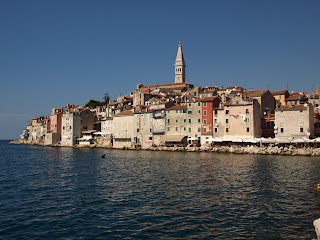Checked out of Hotel Plitvice and went on a wonderful hike around the upper lakes for a couple of hours before heading to Split. The weather was foggy as we started out but cleared up as we headed down to sea level. The drive was a 2.5 hr breeze as we were on secondary or Interstate highways all the way into Split. Coming into Croatia's second largest city (population 200,000) is not a pretty sight and I must say, looking at the street and the building where our apartment is located was also a bit unnerving as it was at best a bit shabby looking. However, once we had lugged our luggage up 5 flights of stairs to our penthouse apartment, we were very happy. Lot's of space, very modern and clean. The best part is we are only a 5 minute walk from Old Town Split which we will thoroughly explore tomorrow.
Old Town Split was once the huge retirement palace of the Roman Emporer Diocletian, who had grown up just inland of Split. In 295 he started the construction of his 28,900 square meter palace (you can fit over 52 NFL football fields inside the walls) which only took 11 years to buid but cost 2,000 slaves their lives. When finished it had a sewer system, fresh running water and healing sulpher springs water within its walls. This monsterous complex was two impressive structures in one: luxurious villa and fortified Roman town. Diocletian and his family moved into the palace on his retirement as Emperor of Rome in 305 and lived there until his death in 313. The family lived in the seaside half of the palace and his 700 servants, bodyguards and soldiers lived in the back half. After his death the palace remained an imperial posession until the fall of the Roman Empire late in the 5th century, at which time it was abandoned. It was'nt until the 7th century that the inhabitants of nearby Salona took refuge in the palace grounds fleeing a Slavic invasion and never left. Even today, 2000 people live or work inside the palace walls amid a maze of narrow alleys that are home to fashionable boutiques, galleries, hotels, outdoor cafes and apartments.
It was a hot and sunny day (28c) with no wind as we started our exploration of the Old Town. We spent the whole day inside the palace grounds marveling at how some of these structures still survived after 1,700 years and enjoying little breaks at wonderful little cafes for cappucinos and local beers. Walked home weary but happy and looking forward to a delicious Rita prepared Greek salad and a good nights sleep.
The Diva on the Riva, Split's waterfront promenade between the sea and the Old Town walls
The Emperors mausoleum was converted to a cathedral in the 7th century and construction of the 200-foot-tall bell tower was started in the 13th century and took 300 years to complete
Spectacular view of Split, harbor and surrounding area after climbing the 183 steps of the bell tower
One of the charming plazas where we did some serious people watching over a cappacino
Taking a well deserved break and relaxing on our balcony before getting dinner ready
Rita preparing dinner in our well functioning apartment
Old Town Split was once the huge retirement palace of the Roman Emporer Diocletian, who had grown up just inland of Split. In 295 he started the construction of his 28,900 square meter palace (you can fit over 52 NFL football fields inside the walls) which only took 11 years to buid but cost 2,000 slaves their lives. When finished it had a sewer system, fresh running water and healing sulpher springs water within its walls. This monsterous complex was two impressive structures in one: luxurious villa and fortified Roman town. Diocletian and his family moved into the palace on his retirement as Emperor of Rome in 305 and lived there until his death in 313. The family lived in the seaside half of the palace and his 700 servants, bodyguards and soldiers lived in the back half. After his death the palace remained an imperial posession until the fall of the Roman Empire late in the 5th century, at which time it was abandoned. It was'nt until the 7th century that the inhabitants of nearby Salona took refuge in the palace grounds fleeing a Slavic invasion and never left. Even today, 2000 people live or work inside the palace walls amid a maze of narrow alleys that are home to fashionable boutiques, galleries, hotels, outdoor cafes and apartments.
It was a hot and sunny day (28c) with no wind as we started our exploration of the Old Town. We spent the whole day inside the palace grounds marveling at how some of these structures still survived after 1,700 years and enjoying little breaks at wonderful little cafes for cappucinos and local beers. Walked home weary but happy and looking forward to a delicious Rita prepared Greek salad and a good nights sleep.
The Diva on the Riva, Split's waterfront promenade between the sea and the Old Town walls
The Emperors mausoleum was converted to a cathedral in the 7th century and construction of the 200-foot-tall bell tower was started in the 13th century and took 300 years to complete
Spectacular view of Split, harbor and surrounding area after climbing the 183 steps of the bell tower
One of the charming plazas where we did some serious people watching over a cappacino
Taking a well deserved break and relaxing on our balcony before getting dinner ready
Rita preparing dinner in our well functioning apartment

























































